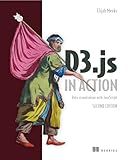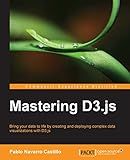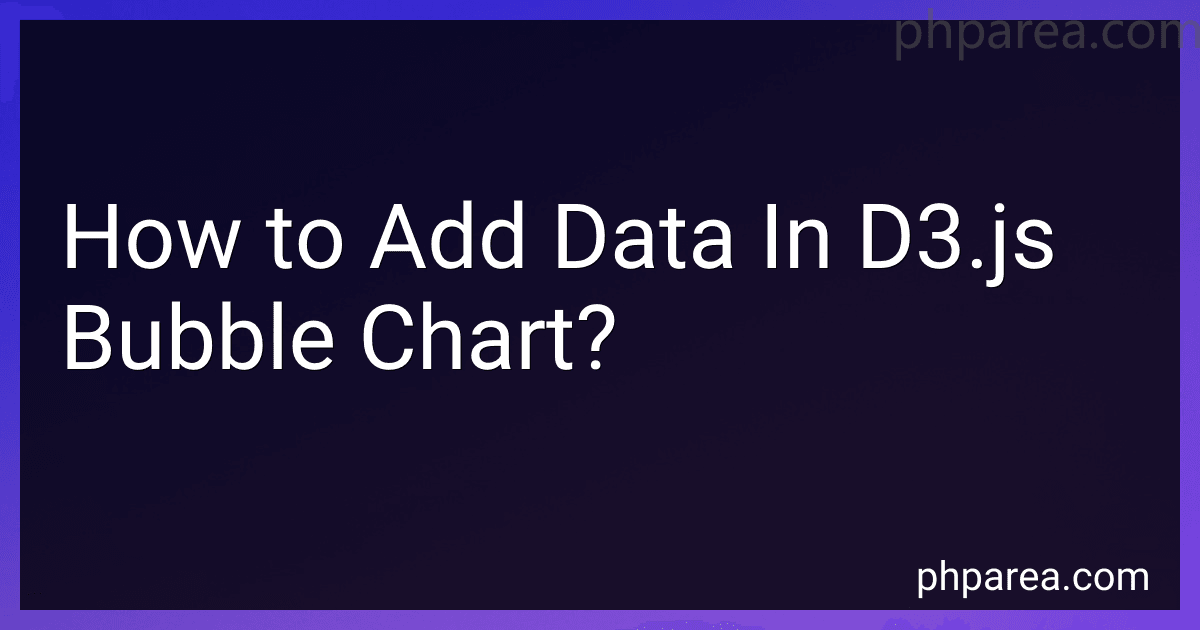Best Tools for Creating D3.js Bubble Charts to Buy in December 2025

D3.js in Action, Third Edition



D3.js in Action: Data visualization with JavaScript



Interactive Data Visualization for the Web: An Introduction to Designing with D3



Mastering D3.js - Data Visualization for JavaScript Developers


To add data in a d3.js bubble chart, you first need to create an array of objects that represent the data points you want to display. Each object should have properties that define the size of the bubble, its x and y coordinates, and any other relevant information you want to display.
Next, you will need to bind this data to the bubbles in your chart using the d3.js enter() function. This function will create new elements for each data point that is not already represented in the chart. You can then set the attributes of these elements, such as their position and size, based on the data values.
Finally, you can style the bubbles using CSS or inline styles to make them visually appealing. You can also add tooltips or labels to provide additional information about each data point when the user hovers over a bubble.
Overall, adding data to a d3.js bubble chart involves creating data objects, binding them to chart elements, and styling the bubbles to create an informative and visually appealing visualization.
How to add a background image to a d3.js bubble chart?
To add a background image to a d3.js bubble chart, you can follow these steps:
- First, create a container element where you want to display the bubble chart. For example, you can create a element with an id of "chart-container".
- Then, add the following CSS styles to define the background image for the container. You can replace 'url("your-image-url")' with the URL of the image you want to use as the background.
#chart-container { background: url("your-image-url"); background-size: cover; background-repeat: no-repeat; background-position: center; }
- Next, create a d3.js bubble chart using the container element as the target. Here is an example code snippet for creating a simple bubble chart:
// Create the SVG element for the chart var svg = d3.select("#chart-container") .append("svg") .attr("width", 400) .attr("height", 400);
// Define the data for the bubbles var data = [ { name: "A", value: 10 }, { name: "B", value: 20 }, { name: "C", value: 30 } ];
// Create a bubble layout var bubble = d3.pack(data) .size([400, 400]) .padding(1.5);
// Generate the bubble nodes var nodes = d3.hierarchy({children: data}) .sum(function(d) { return d.value; });
// Create the bubble circles var bubbleCircles = svg.selectAll(".bubble") .data(bubble(nodes).descendants()) .enter() .append("circle") .attr("class", "bubble") .attr("cx", function(d) { return d.x; }) .attr("cy", function(d) { return d.y; }) .attr("r", function(d) { return d.r; }) .style("fill", "blue");
By following these steps, you should be able to add a background image to your d3.js bubble chart.
What is the default bubble size in a d3.js bubble chart?
There is no default bubble size in a d3.js bubble chart as it depends on the data values provided for each bubble. The size of each bubble in a d3.js bubble chart is determined by the value of a specified property in the data, such as a numerical value representing the size of the bubble.
What are some best practices for designing a d3.js bubble chart?
- Choose the right data: Ensure that the data you use for your bubble chart is suitable for visualizing relationships between different variables. It should be organized in a way that makes it easy to map to the different attributes of the bubbles.
- Define the bubble size and color: Use appropriate scaling and color schemes to represent the different attributes of the data. Consider using a logarithmic scale for bubble sizes to avoid overwhelming the visualization with a few large bubbles.
- Use tooltips: Include tooltips to provide additional context and information when users hover over the bubbles. This can help users understand the data and make it easier to interpret the chart.
- Handle data updates and transitions: Implement smooth transitions when updating the data or changing the layout of the chart. This will make the changes more visually appealing and help users understand the data better.
- Label the bubbles: Consider adding labels to the bubbles to provide more context and help users understand the data at a glance. You can adjust the positioning and size of the labels to avoid overcrowding the chart.
- Consider interactions: Think about how users will interact with the bubble chart and incorporate zooming, panning, and filtering options to allow users to explore the data more effectively.
- Responsiveness: Make sure your bubble chart is responsive and works well on different devices and screen sizes. Test the chart on various devices and adjust the layout and design as needed to ensure a seamless user experience.
How to add a trendline to a d3.js bubble chart?
To add a trendline to a d3.js bubble chart, you can use the d3-regression package to calculate the regression line based on your data points. Here's a step-by-step guide to adding a trendline to a bubble chart:
- Install the d3-regression package by running the following command in your terminal:
npm install d3-regression
- Import the necessary modules in your JavaScript file:
import * as d3 from 'd3'; import { regressionLinear } from 'd3-regression';
- Calculate the regression line based on your data points. For example, if you have an array of data points stored in a variable named data:
const regressionData = regressionLinear(data.map(d => [d.x, d.y]));
- Append a line element to your SVG container representing the regression line:
svg.append('line') .attr('x1', xScale.range()[0]) .attr('y1', yScale(regressionData.predict(xScale.domain()[0]))) .attr('x2', xScale.range()[1]) .attr('y2', yScale(regressionData.predict(xScale.domain()[1]))) .style('stroke', 'red') .style('stroke-width', 2);
Make sure to adjust the x1, y1, x2, and y2 attributes of the line element based on your chart's scales and the regression line data.
- Your bubble chart should now have a trendline added to it. You can customize the appearance of the trendline by adjusting the styling attributes of the line element.
By following these steps, you should be able to successfully add a trendline to your d3.js bubble chart.
